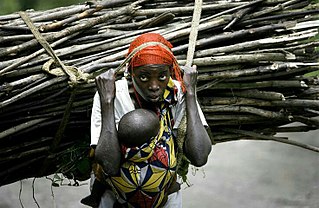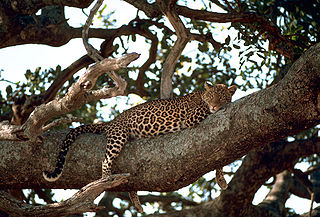Related Research Articles

A tremor is an involuntary, somewhat rhythmic, muscle contraction and relaxation involving oscillations or twitching movements of one or more body parts. It is the most common of all involuntary movements and can affect the hands, arms, eyes, face, head, vocal folds, trunk, and legs. Most tremors occur in the hands. In some people, a tremor is a symptom of another neurological disorder. A very common tremor is the teeth chattering, usually induced by cold temperatures or by fear.

Biophysics is an interdisciplinary science that applies approaches and methods traditionally used in physics to study biological phenomena. Biophysics covers all scales of biological organization, from molecular to organismic and populations. Biophysical research shares significant overlap with biochemistry, molecular biology, physical chemistry, physiology, nanotechnology, bioengineering, computational biology, biomechanics, developmental biology and systems biology.

Biomechanics is the study of the structure, function and motion of the mechanical aspects of biological systems, at any level from whole organisms to organs, cells and cell organelles, using the methods of mechanics. Biomechanics is a branch of biophysics.

The bar-headed goose is a goose that breeds in Central Asia in colonies of thousands near mountain lakes and winters in South Asia, as far south as peninsular India. It lays three to eight eggs at a time in a ground nest. It is known for the extreme altitudes it reaches when migrating across the Himalayas.
Sports science is a discipline that studies how the healthy human body works during exercise, and how sport and physical activity promote health and performance from cellular to whole body perspectives. The study of sports science traditionally incorporates areas of physiology, psychology, anatomy, biomechanics, biochemistry, and biokinetics. Sports scientists and performance consultants are growing in demand and employment numbers, with the ever-increasing focus within the sporting world on achieving the best results possible. Through the scientific study of sport, researchers have developed a greater understanding on how the human body reacts to exercise, training, different environments and many other stimuli.

Ventricular hypertrophy (VH) is thickening of the walls of a ventricle of the heart. Although left ventricular hypertrophy (LVH) is more common, right ventricular hypertrophy (RVH), as well as concurrent hypertrophy of both ventricles can also occur.

Mechanotransduction is any of various mechanisms by which cells convert mechanical stimulus into electrochemical activity. This form of sensory transduction is responsible for a number of senses and physiological processes in the body, including proprioception, touch, balance, and hearing. The basic mechanism of mechanotransduction involves converting mechanical signals into electrical or chemical signals.
A dermal bone or investing bone or membrane bone is a bony structure derived from intramembranous ossification forming components of the vertebrate skeleton including much of the skull, jaws, gill covers, shoulder girdle and fin spines rays (lepidotrichia), and the shell. In contrast to endochondral bone, dermal bone does not form from cartilage that then calcifies, and it is often ornamented. Dermal bone is formed within the dermis and grows by accretion only – the outer portion of the bone is deposited by osteoblasts.
Central venous pressure (CVP) is the blood pressure in the venae cavae, near the right atrium of the heart. CVP reflects the amount of blood returning to the heart and the ability of the heart to pump the blood back into the arterial system. CVP is often a good approximation of right atrial pressure (RAP), although the two terms are not identical, as a pressure differential can sometimes exist between the venae cavae and the right atrium. CVP and RAP can differ when arterial tone is altered. This can be graphically depicted as changes in the slope of the venous return plotted against right atrial pressure.

Exertion is the physical or perceived use of energy. Exertion traditionally connotes a strenuous or costly effort, resulting in generation of force, initiation of motion, or in the performance of work. It often relates to muscular activity and can be quantified, empirically and by measurable metabolic response.

Evolutionary physiology is the study of the biological evolution of physiological structures and processes; that is, the manner in which the functional characteristics of individuals in a population of organisms have responded to natural selection across multiple generations during the history of the population. It is a sub-discipline of both physiology and evolutionary biology. Practitioners in the field come from a variety of backgrounds, including physiology, evolutionary biology, ecology, and genetics.
Physiological and Biochemical Zoology is a peer-reviewed scientific journal published by the University of Chicago Press on behalf of the Society for Integrative and Comparative Biology. Traditionally, it has covered research on the biochemistry, physiology, and genetics of animals. A recent editorial change has expanded the scope to include life-history traits, comparative biomechanics, and behavioral endocrinology, as well as a wider range of paper categories, including those related to educational outreach. The current editor-in-chief is Theodore Garland, Jr.. Previous Editors include Charles Manning Child, Warder Clyde Allee, and Clifford Ladd Prosser. The journal was established in 1928 as Physiological Zoology, obtaining its current name in 1999. According to the Journal Citation Reports, the journal has a 2019 impact factor of 2.250.

Arboreal locomotion is the locomotion of animals in trees. In habitats in which trees are present, animals have evolved to move in them. Some animals may scale trees only occasionally, but others are exclusively arboreal. The habitats pose numerous mechanical challenges to animals moving through them and lead to a variety of anatomical, behavioral and ecological consequences as well as variations throughout different species. Furthermore, many of these same principles may be applied to climbing without trees, such as on rock piles or mountains.
Journal of Experimental Biology is a peer-reviewed scientific journal in the field of comparative physiology and integrative biology. It is published by The Company of Biologists. The journal is partnered with Publons and has two-way integration with bioRxiv. Journal of Experimental Biology is now a hybrid journal and publishes 24 issues a year. Content over six months old is free to read.
William Alexander Bain FRSE DSc was a Scottish pharmacologist, best known for his early work with antihistamine drugs.
The American Journal of Physiology is a peer-reviewed scientific journal on physiology published by the American Physiological Society.

The Microgravity Centre, colloquially known as the "MicroG", at PUCRS university, Porto Alegre, Brazil, was initially created as a laboratory in 1999 by Professor Thais Russomano MD MSc PhD, as the first academic and research establishment dedicated to Space Life Sciences in Latin America. It evolved into a fully multidisciplinary centre in 2006, expanding its areas of research beyond aerospace medicine and engineering, to include pharmaceuticals, biomechanics and physiotherapy, among others.

The Journal of Comparative Physiology A: Neuroethology, Sensory, Neural, and Behavioral Physiology is a monthly peer-reviewed scientific journal covering the intersection of ethology, neuroscience, and physiology. It was established in 1984, when it was split off from the Journal of Comparative Physiology. It was originally subtitled the Journal of Comparative Physiology A: Sensory, Neural, and Behavioral Physiology, obtaining its current name in 2001. The editor-in-chief is Friedrich G. Barth. The journal become electronic only in 2017.

Gerhard Alfred Holzapfel is an Austrian scientist, (bio)mechanician. He is currently a Professor of Biomechanics and Head of the Institute of Biomechanics at Graz University of Technology, Austria, since 2007. He is also the International Chair of Biomechanics at the Norwegian University of Science and Technology (NTNU), and a visiting professor at the School of Mathematics and Statistics, University of Glasgow, Scotland. He was a Professor of Biomechanics at KTH Royal Institute of Technology in Stockholm, Sweden, for 9 years until 2013. He is the co-founder and co-editor-in-chief of the international scientific journal Biomechanics and Modeling in Mechanobiology by Springer Nature since the first issue published in June 2002.
Alejandro Rico-Guevara is an evolutionary biologist and behavioral ecophysicist. His scientific research has focused on nectar-feeding animals with an emphasis on hummingbird bill morphology and biomechanics. He is an assistant professor at the University of Washington Biology Department and Curator of Ornithology at the Burke Museum of Natural History and Culture.
References
- ↑ Mark Denny; Brian Helmuth (2009-07-21). "Confronting the physiological bottleneck: A challenge from ecomechanics". Integrative and Comparative Biology. 49 (3): 197–201. doi:10.1093/icb/icp070. PMC 2895352 . PMID 20607137.